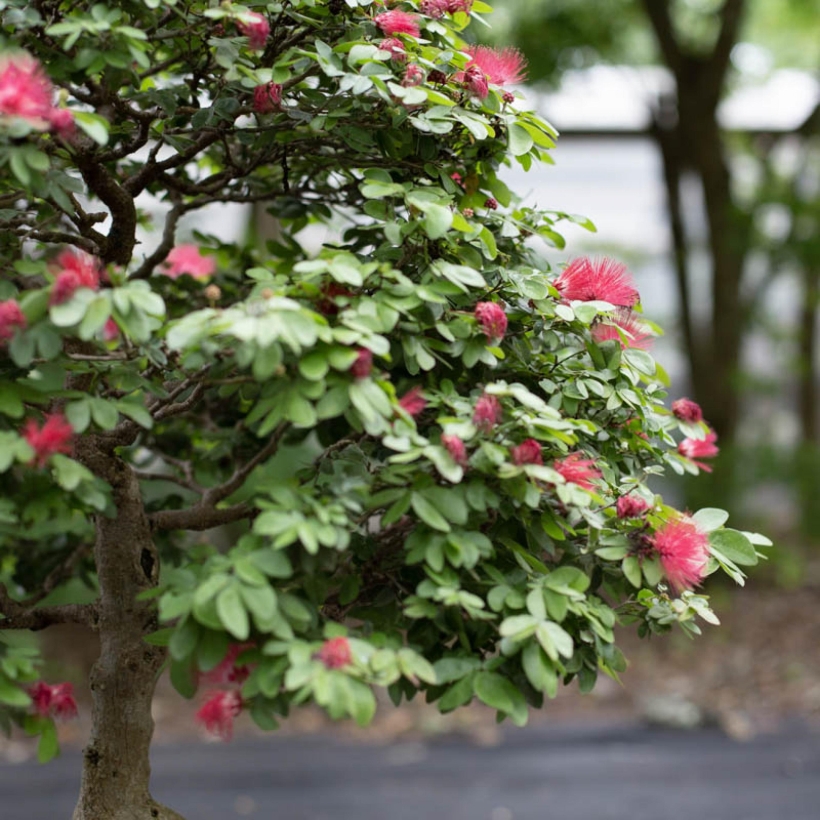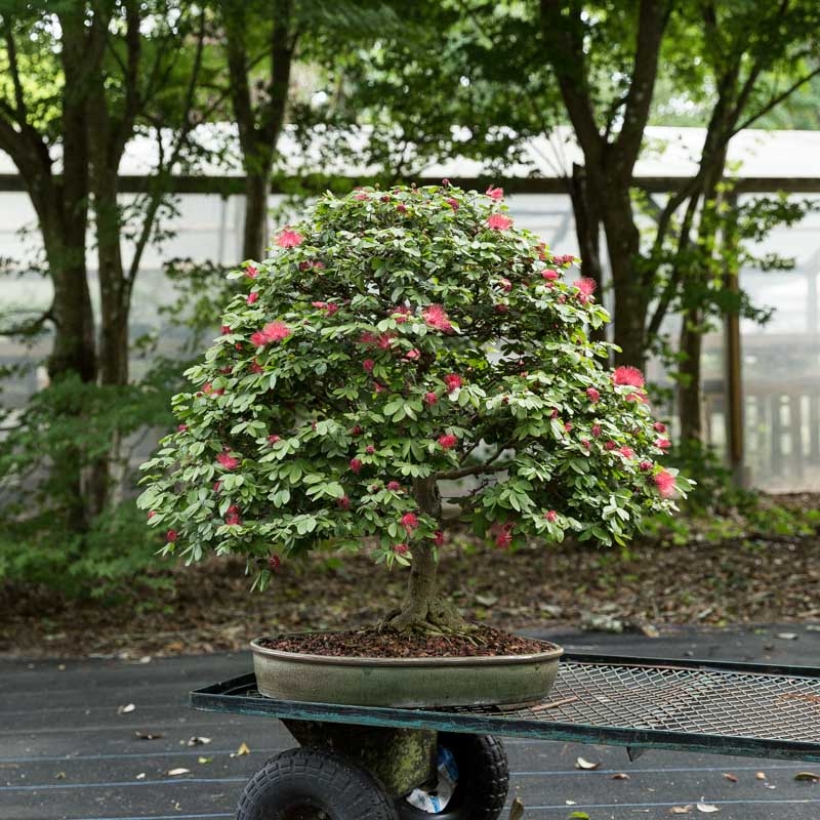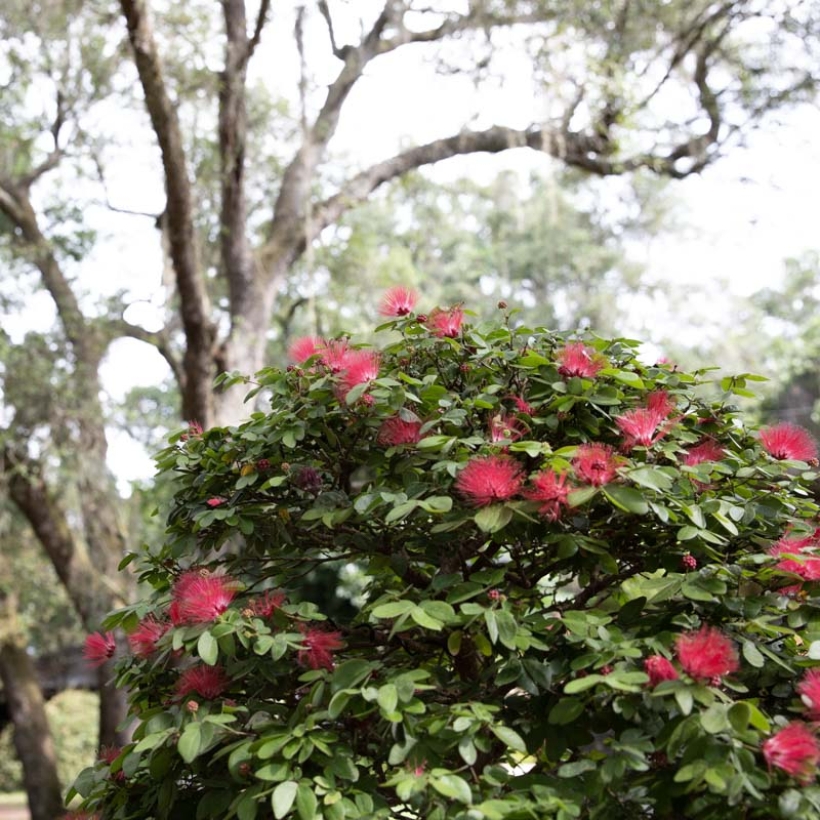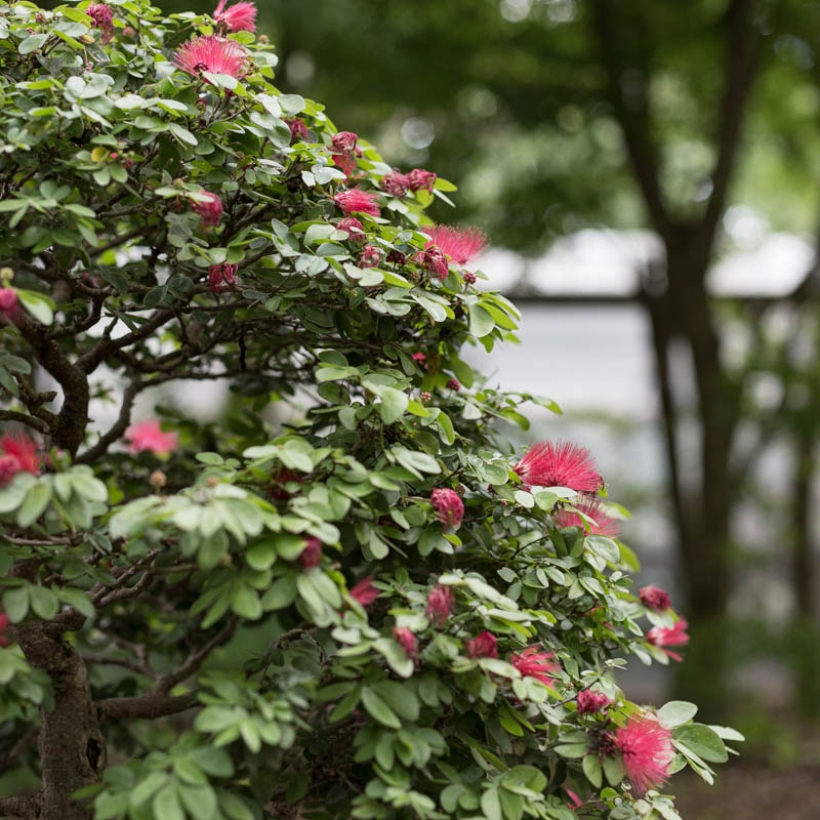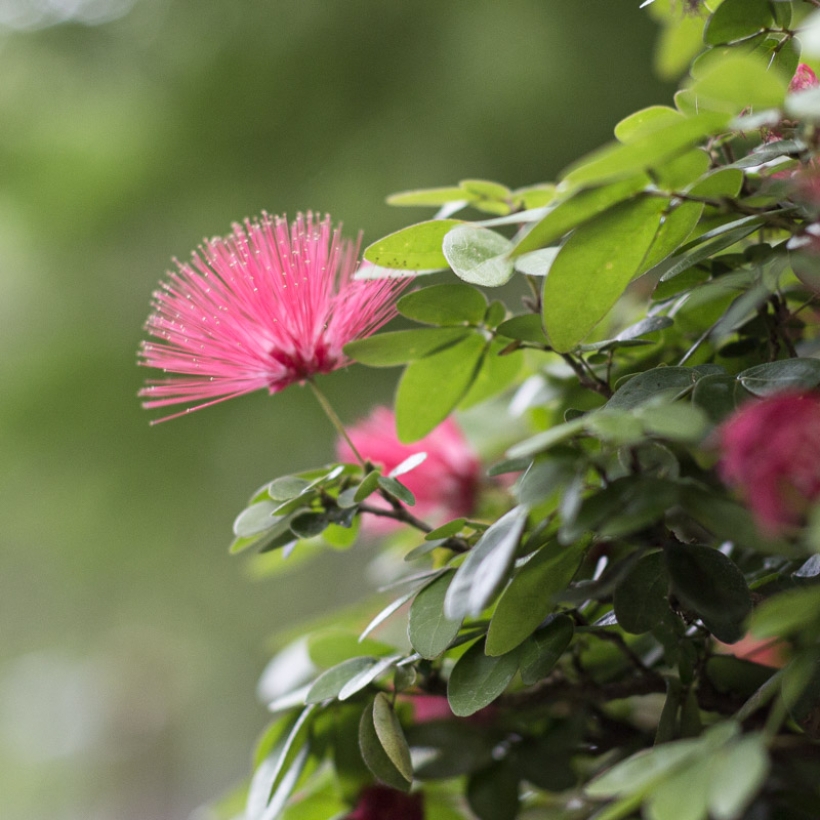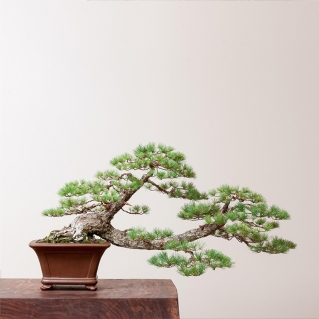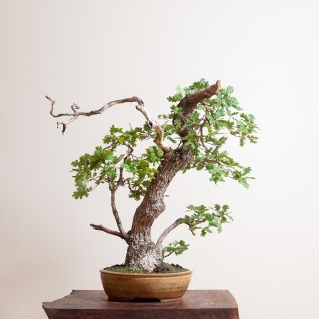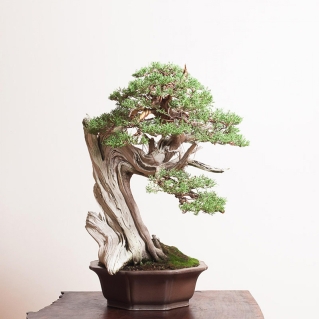Dwarf Powder Puff Bonsai

General Information
Dwarf powder puff—calliandra emarginata—is a dwarf variety that’s very common in bonsai and known for its pom-pom-like flowers. Loved by pollinators, such as hummingbirds, butterflies, and bees, these trees are perfect for the outdoors.
Dwarf powder puff is a tropical, broadleaf evergreen native to South and Central America, and is fast metabolizing and cold-sensitive. The bark has a very creamy, almost khaki-like appearance that contrasts beautifully with the dull leaves and unique flowers.
A versatile variety, dwarf powder puffs can be displayed in glazed or unglazed pottery and they’re sure to stand out.
Two similar varieties of powder puff trees—calliandra surinamensis and calliandra schultzii—are also popular in bonsai and require the same care as calliandra emarginata, but differ in appearance.
Calliandra surinamensis has fragrant, pink flowers and is known to have more pairs of leaflets than the emarginata and is commonly found in Brazil. The calliandra schultzii is a cascading tree that consists of a pink, fragrant flower with white at the base and is more commonly seen in Ecuador.
Each of the three calliandra powder puff trees is considered desirable for beginner or established bonsai artists because of their versatility and their ability to thrive in tropical environments and greenhouses.
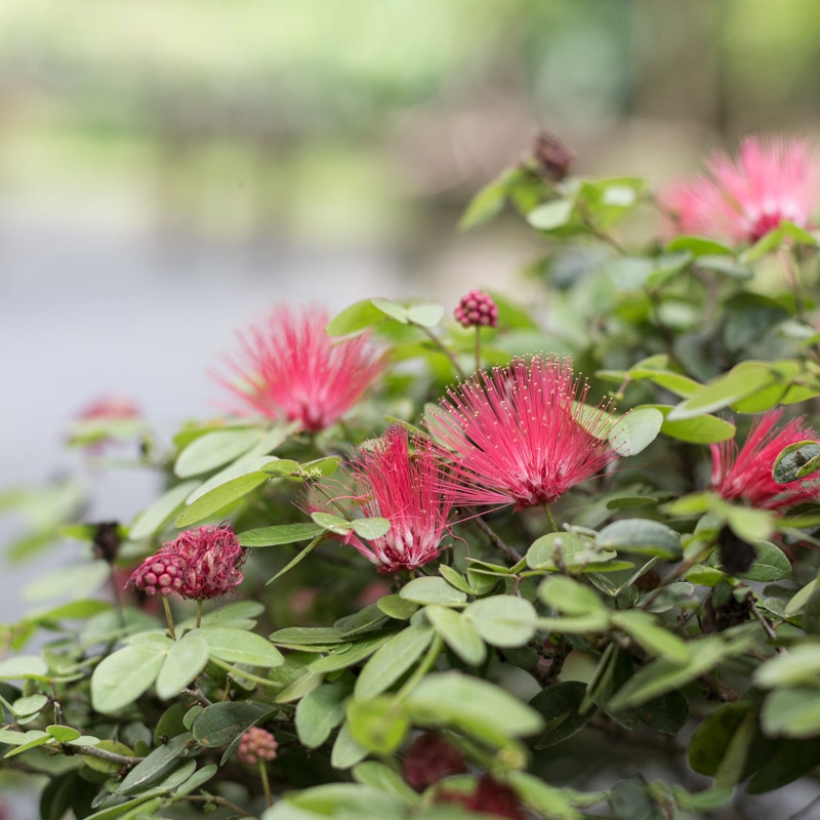
Caring for Dwarf Powder Puff Bonsai
Watering
Dwarf powder puffs require a lot of water during the growing season, especially in summer.
They originate from the lagoon family, so if it’s too hot in the afternoon their leaves close up to control water loss. This can confuse people into believing the tree is wilting, causing them to overwater by accident.
It’s important to use well-draining soil to allow plenty of water without becoming overly saturated. Because the dwarf powder puff continues to grow during the winter, you will need to keep them a little more moist than you would most tropicals. However, you don’t want to overdo it.
Good saturation around the pot will ensure that you don’t allow a dominant root.
Sun Exposure
Dwarf powder puff trees love full sun. They’re very tolerant of light in any position, and if they’re feeling deprived of light you’ll notice the leaves will get bigger and the tree will bloom less.
Try to give your dwarf powder puff as much sun as possible, and if your sun is directional, you’ll want to rotate your tree to avoid losing density.
Temperature
The two main factors to consider where temperature is concerned is the right temperature to protect the tree and the right temperature to do work on the tree.
In terms of protecting your dwarf powder puff, they cannot tolerate temperatures below 40-45°F.
When working on your dwarf powder puff, you’ll want to maintain a temperature that is consistently above 60°F during day and night.
Fertilizing
As you establish your dwarf powder puff you can fertilize sparingly just a few inches from the base. It’s best to use a time-released fertilizer on a tri-annual basis. Unfertilized trees will grow at a slower pace.
Pruning
Pruning and temperature go hand-in-hand. Because dwarf powder puff is a vascular dominant tree, meaning the storage system is within the trunk.
When pruning dwarf powder puff, you can work on both the roots and the branches at the same time, but you shouldn’t prune the roots as heavily as the branches and the tree should be well protected from the sun.
Dwarf powder puffs don’t heal incredibly well. When making larger trunk chops or branch removal, it can take a significant amount of time to close up.
Sealing the wound and using a duct seal can keep water out and may help dramatically, but it’s still a very slow healing tree. With this in mind, pruning should be planned. Consider where you plan to cut as this will need to be incorporated into the long-term design of the tree.
Dwarf powder puff can be cut back to two pairs of leaves—two nodes—then allowing these to grow and branch out.
The ramification of dwarf powder puff comes from root maturation in great sunlight with proper pruning. You won’t gain anything from defoliation and it may kill the tree.
Wiring
Dwarf powder puff can be wired when they’re younger, but get brittle the larger they get. Wiring the primary branches in the early stages will help establish the shape of the tree, but when you get into second stage development—or refinement—you should only wire the secondary and tertiary branches based on flexibility.
Repotting
Dwarf powder puffs need time for the roots to mature. By allowing the branches and roots to develop, and giving them proper water and light, you’ll get the desired growth you’re looking for much sooner than if you are to repot every couple of years.
The time to repot your dwarf powder puff is when you no longer see water saturation, your root is established in the pot, and you’re ready to design it.
If you have a long-running root, it’s important to track it to the beginning before cutting or you run the risk of losing a large portion of your root mass.
You’re ready to move your dwarf powder puff into a bonsai container at the point of secondary and tertiary branch development. From that point, you will be maintaining the finer growth and allowing the tree growth to slow down.
Propagation
Trees from the lagoon family create seed pods, but in bonsai, the easiest way to propagate your dwarf powder puff is through air layering.
When air layering your dwarf powder puff, you’ll want to use a rooting hormone and synthetic oxygen. Sphagnum moss should be used sparingly because the roots will be very fragile until they harden off.
Cuttings can be a little trickier and are not usually recommended. However, if you choose to do cuttings, you’ll want to use rooting hormone when propagating as well.
Pests/Disease
The most common pests found in dwarf powder puff are aphids, scales, and ants, usually during the growing season.
The easiest way to avoid and deal with these pests is to use a soapy water solution on the trunk and branches of the tree. Dwarf powder puff trees flower almost every three weeks and are constantly attracting pollinators. The best way to avoid killing pollinators is to limit the use of chemical pesticides.
If soapy water isn’t doing enough to keep the pests away, you may want to consider repotting the tree to ensure the soil is in good shape. This is the main intake system for the tree, and if it’s working correctly the tree should defend itself from most pests.
Dwarf Powder Puff Bonsai FAQS
We recommend for all calliandra species, including dwarf powder puff, that you keep it outside in full sun.
While the tree can be kept inside, it might not do as well, unless it’s sitting in direct sunlight all day. Households using air conditioning may find that the tree doesn’t produce many leaves or flowers and that the leaves are closed most of the time.
Additionally, root rot is more common among indoor dwarf powder puffs. They like a lot of water and when indoors that moisture can’t transpire as well.
A regular well-draining soil along with leaf mold, peat moss, or compost will help improve drainage and maintain soil quality.
